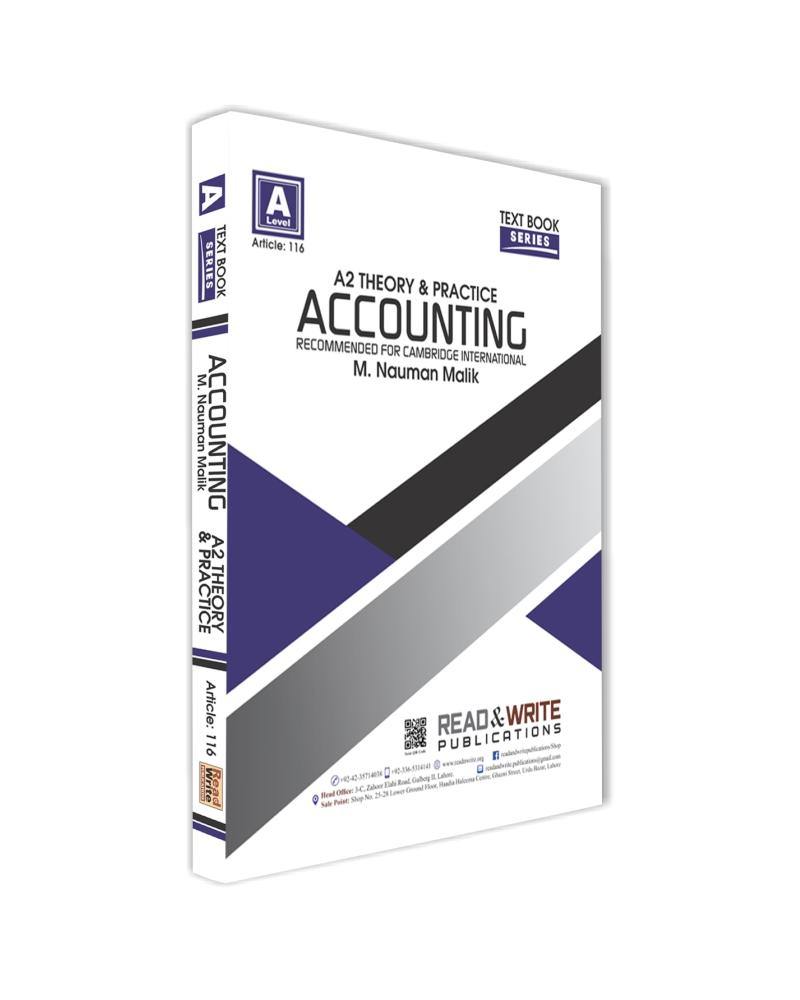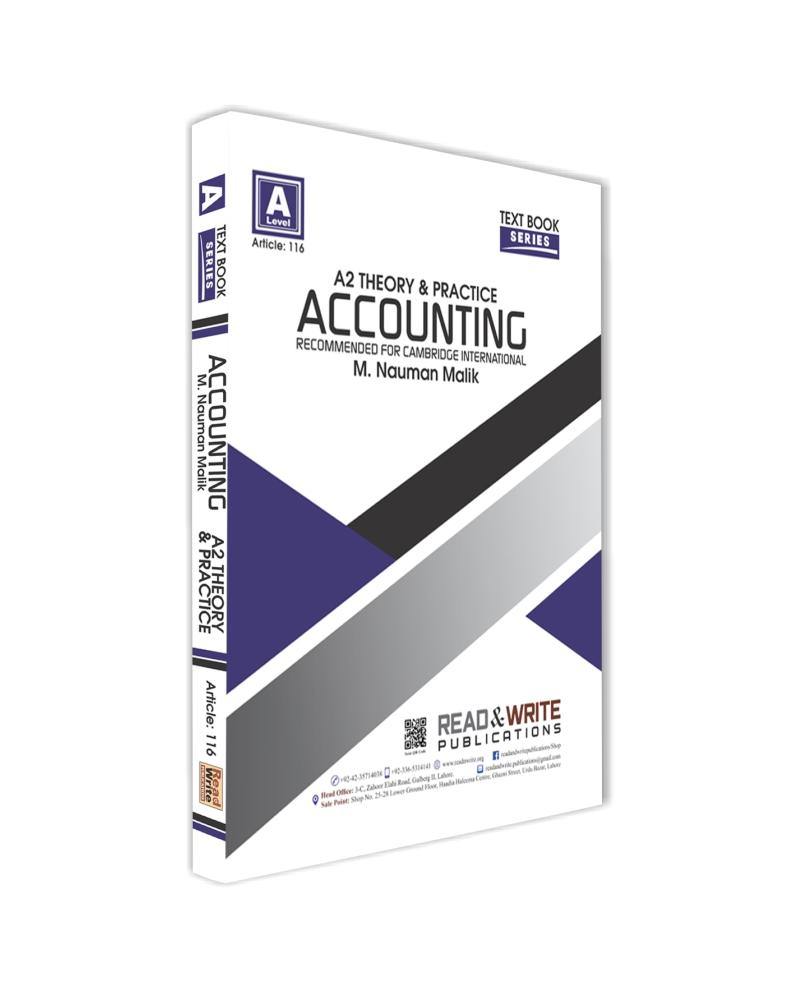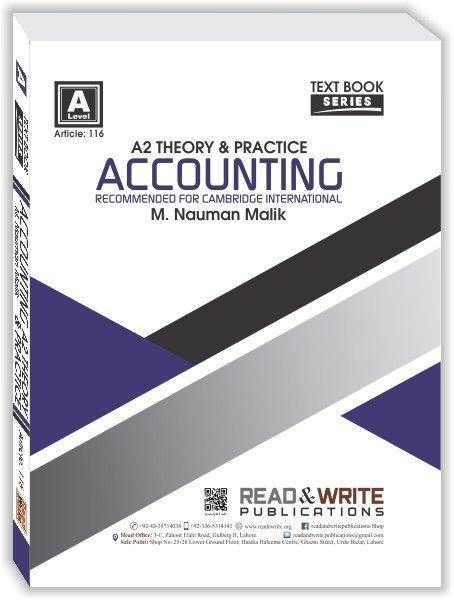Cambridge
Cambridge Accounting A2-Level Text Book Series Theory and Practice By M. Nauman Malik (Article No. 116)
Cambridge Accounting A2-Level Text Book Series Theory and Practice By M. Nauman Malik (Article No. 116)
Couldn't load pickup availability
Accounting A Level Theory And Practice Book
The globalized frame work of Cambridge International Advanced Level, in practice over 125 countries, has led to the introduction of an international format and layout for all its syllabuses. With a thorough discussion of the basic double entry principles for the beginners, the ‘A2 Accounting – Theory & Practice’ is also useful for those who have some knowledge.
The strengths and weaknesses of accounting practices are reinforced by a set of Review Questions at the end of each chapter, enabling the students to put, what is learnt, into practice. These Questions have been developed by the author and are not taken from past exam papers and Accounting A2 Level Theory and Practice Books.
This book is completely revised and updated to fully comply with the new CIE Advanced Level Accounting syllabus for 2016-18. Five new chapters have been included in the book in view of the new syllabus.
These topics include ’Auditing and stewardship of limited companies’, ‘Consignment Accounting, Joint Ventures’, ‘Activity based costing’ and ‘Computerized accounts’.
In addition, topics like ‘manufacturing accounts’, ‘non-profit organization have been shifted from ‘AS Accounting – theory and practice’ to this book. New material on overhead costing is also added to the topic ‘standard costing’. As syllabus contents relating to topics like ‘ratios’ and ‘Accounting standards’ have been reduced in new syllabus so these topics have been rewritten accordingly. Solutions to odd numbered questions are given in the appendix at the end of the book.
In addition solutions to even numbered questions are available in a separate manual. Teachers using “A2 Accounting – Theory & Practice” as a text book, may get the manual by applying officially on a school letterhead. Providing the students with a solid foundation in the “Why” as well as the “How” of accounting concepts, the emphasis is put on understanding rather than mere cramming.
A brief list of learning objectives at the beginning of each chapter will assist the readers to determine the things they should understand while going through the chapter.
Hence, checking back may help them to identify weak areas which still need thorough review. Constructive criticism and suggestions to make the subsequent editions more useful would be appreciated and thankfully acknowledged.
CHAPTER 1 ACCOUNTING FOR NON PROFIT ORGANISATIONS
1 COMPARISON BETWEEN PROFIT AND NON- PROFIT MAKING ORGANIZATIONS Accounting A Level Theory And Practice Book
1 INCOMES AND EXPENSES OF NON PROFIT ORGANIZATIONS
1 Incomes of Non Profit Organizations
1 Expenses of Non Profit organizations
1 SOME PECULIAR TERMS OF NON PROFIT ORGANIZATIONS
1 Life Membership fee
1 Legacy
1 Gift
1 Grants and Donations
1 ACCOUNTING BY NON PROFIT ORGANIZATIONS
1 Receipts and Payments Account
1 Income and Expenditure Account
1 Trading Account
1 Income and Expenses on Same Head
1 Accounting for Subscriptions
1 PREPARATION OF FINANCIAL STATEMENTS
REVIEW QUESTIONS
2 REASONS OF SELLING A BUSINESS
2 REALIZATION ACCOUNT
2 ACCOUNTING TREATMENT ON SALE OF BUSINESS
2 Assets on Dissolution
2 Goodwill on Dissolution
2 Liabilities on Dissolution
2 Expenses on Dissolution
2 Profit (loss) on Realization Account
2 Partners’ Loans Accounts on Dissolution
2 Current Account Balances on Dissolution
2 Cash or Bank Balance on Dissolution
2 Partners’ Capital Accounts on Dissolution
2 SALE OF BUSINESS TO A COMPANY
REVIEW QUESTIONS
3 PURCHASED GOODWILL
3 INTERNALLY DEVELOPED GOODWILL
3 PERSONAL GOODWILL
3 THE OPPOSITE OF PAYING FOR GOODWILL (NEGATIVE GOODWILL)
3 Accounting for Negative Goodwill
3 DIFFERENCE BETWEEN THE PURCHASE OF A BUSINESS AND THE PURCHASE OF ASSETS
3 COMPONENTS OF PURCHASE CONSIDERATION
3 Assets Taken Over
3 Liabilities Taken Over
3 DISSOLUTION EXPENSES
3 ACCOUNTING TREATMENT OF AMALGAMATION OF BUSINESSES
3 DISTINCTION BETWEEN AMALGAMATION AND PURCHASE OF BUSINESS
3 AMALGAMATION OF BUSINESSES
3 Reasons for Amalgamation
3 Accounting Procedure
3 Goodwill on Amalgamation
3 CONVERSION OF PARTNERSHIP INTO COMPANY
3 PAYMENT FOR PURCHASE OF BUSINESS – PURCHASE CONSIDERATION
3 ENTRIES TO RECORD THE PURCHASE OF BUSINESS
3 CASH AND BANK BALANCES OF PARTNERSHIPS ON PURCHASE
3 RETURN ON INVESTMENT
REVIEW QUESTIONS
CHAPTER 4 COMPANY FINANCIAL STATEMENTS
4 THE NEED FOR COMPANIES
4 SOURCES OF FINANCE FOR A COMPANY
4 TYPES OF SHARES
4 Ordinary Shares
4 Preference Shares
4 DEBENTURES
4 CONVERTIBLE LOAN STOCK
4 PUBLISHED ACCOUNTS OF LIMITED COMPANIES
4 Role of IAS 1 in Preparation of Accounts
4 Accounting Concepts Applied in Preparation of Accounts
4 Structure and Content of Financial Statements
4 Reporting Period
4 INCOME STATEMENT
4 STATEMENT OF FINANCIAL POSITION (BALANCE SHEET)
4 Assets
4 Liabilities
4 Net Current Assets
4 Equity
4 NOTES TO THE FINANCIAL STATEMENTS
4 STATEMENT OF CHANGES IN EQUITY
4 DIVIDENDS ON ORDINARY SHARES
4 IAS rules for Ordinary dividends
4 WHY COMPANY ACCOUNTS ARE PUBLISHED?
4 LIMITATIONS OF PUBLISHED COMPANY ACCOUNTS
4 FINANCIAL STATEMENTS IN CIE EXAMS
4 RESERVES
4 DIFFERENCE BETWEEN PROVISIONS AND RESERVES
4 DIRECTORS’ REPORT
REVIEW QUESTIONS
CHAPTER 5 ISSUE OF SHARES & DEBENTURES
5 PRICES OF A SHARE
5 Par Value
5 Issue Price
5 Book Value
5 Market Value
5 SELLING SHARES TO THE GENERAL PUBLIC
5 Issue of Shares at Par
5 Issue of Shares at Premium (at a price more than face value)
5 RIGHTS ISSUE
5 Advantages of Rights Issue
5 Disadvantages of Rights Issue
5 BONUS OR SCRIP ISSUE
5 Reasons for Bonus Issue
5 Effect on Earnings per Share (EPS)
5 Advantages of Bonus Issue
5 Disadvantages of Bonus Issue
5 DIFFERENCE BETWEEN RIGHTS AND BONUS ISSUE
5 ISSUE OF LOANS AND DEBENTURES
5 Issue of Debentures at Par
5 Issue of Debentures at Premium (at a Price more than Face Value)
5 Issue of Debentures at Discount (at a Price below Face Value)
REVIEW QUESTIONS
CHAPTER 6 STATEMENT OF CASH FLOWS
6 CLASSIFICATIONS OF CASH FLOWS – AN EXAMPLE
6 CASH AND CASH EQUIVALENTS
6 Cash
6 Cash Equivalents
6 Bank Overdrafts
6 PREPARATION OF A STATEMENT OF CASH FLOWS
6 CASH FLOW FROM OPERATING ACTIVITIES
6 Importance of Cash Flow from Operating Activities
6 CALCULATION OF CASH FLOW FROM OPERATING ACTIVITIES
6 Cash from Operating Activities in Direct Method
6 Cash from Operating Activities in Indirect Method
6 CALCULATION OF OPERATING PROFIT
6 INVESTING ACTIVITIES
6 FINANCING ACTIVITIES
6 CASH FLOW AT A GLANCE
6 USES OF A STATEMENT OF CASH FLOWS
6 LIMITATIONS OF A STATEMENT OF CASH FLOWS
6 USERS OF STATEMENT OF CASH FLOWS
6 DISCLOSURE OF NON CASH ACTIVITIES
6 STATEMENT OF CASH FLOWS FOR BUSINESSES OTHER THAN LIMITED COMPANIES
REVIEW QUESTIONS
CHAPTER 7 INTERNATIONAL ACCOUNTING STANDARDS
IAS 1 PRESENTATION OF FINANCIAL STATEMENTS
IAS 2 INVENTORIES
IAS 7 STATEMENT OF CASH FLOWS
IAS 8 ACCOUNTING POLICIES, CHANGES IN ACCOUNTING ESTIMATES AND ERRORS
IAS 10 EVENTS AFTER THE REPORTING PERIOD
IAS 16 PROPERTY, PLANT, AND EQUIPMENT
IAS 36 IMPAIRMENT OF ASSETS
IAS 37 PROVISIONS, CONTINGENT LIABILITIES AND CONTINGENT ASSETS
IAS 38 INTANGIBLE ASSETS
7 ETHICS RELATING TO THE PRACTICE OF ACCOUNTING
REVIEW QUESTIONS
CHAPTER 8 AUDITING AND STEWARDSHIP OF LIMITED COMPANIES
8 ROLE OF DIRECTORS
8 ROLE OF AUDITORS
8 PREPARATION AND RENDERING OF AUDITORS’ REPORT
8 Types of opinion
8 Understand the Entity’s Environment
8 WHAT IS NOT EXPECTED FROM AUDITORS
8 DIFFERENCE BETWEEN THE DUTIES OF MANAGEMENT AND AUDITORS
8 TRUE AND FAIR VIEW IN FINANCIAL STATEMENTS
CHAPTER 9 RATIO ANALYSIS
9 FINANCIAL RATIOS
9 ANALYSIS OF RATIOS
9 Comparing one Year with Another (Trend or Time Series Analysis)
9 Comparing one Business with another Business (Cross-Sectional Analysis)
9 DEMONSTRATION OF RATIOS
9 RATIOS IN ADVANCED LEVEL SYLLABUS
9 Working Capital Cycle
9 Net Working Assets to Sales (revenue)
9 Earnings per Share
9 Price-Earnings (P/E) ratio
9 Dividend per Share
9 Dividend yield ratio
9 Dividend Cover
9 Income Gearing
9 Gearing
9 USES OF RATIO ANALYSIS
9 LIMITATIONS OF RATIO ANALYSIS
9 USERS OF FINANCIAL RATIOS
REVIEW QUESTIONS
CHAPTER 10 JOINT VENTURE ACCOUNTS
10 FEATURES OF JOINT VENTURES
10 OBJECTIVES OF JOINT VENTURES
10 EXAMPLES OF JOINT VENTURES:
10 PARTNERSHIPS AND JOINT VENTURES COMPARED
10 DIFFERENCE BETWEEN CONSIGNMENT AND JOINT VENTURES
10 ACCOUNTING FOR JOINT VENTURES
REVIEW QUESTIONS
11 CHARACTERISTICS OF CONSIGNMENT
11 DIFFERENCE BETWEEN CONSIGNMENT AND SALE
11 TERMS USED IN CONSIGNMENT ACCOUNTS
11 Consignor
11 Consignee
11 GOODS SENT ON CONSIGNMENT
11 PROFORMA INVOICE
11 EXPENSES ON CONSIGNMENT
11 Commission
11 LOSSES ON CONSIGNMENT
11 Normal Loss
11 Abnormal Loss
11 ACCOUNT SALES
11 ADVANCE PAYMENTS BY CONSIGNEE
11 VALUATION OF INVENTORY
11 RETURN OF GOODS BY THE CONSIGNEE
11 ACCOUNTS PREPARED BY CONSIGNOR
11 Consignment Account
11 Consignee’s Account
11 Consignment of goods at invoice price (at cost plus profit)
REVIEW QUESTIONS
CHAPTER 12 MANUFACTURING ACCOUNTS
12 THE PRIME COST SECTION
12 Raw Materials Cost
12 Direct Labour Cost
12 Direct expenses
12 FACTORY (PRODUCTION) OVERHEADS
12 MANUFACTURING ACCOUNTS FOR SEPARATE PRODUCTS
12 PURPOSE OF MANUFACTURING ACCOUNTS
12 TRADING SECTION
12 PROFIT AND LOSS SECTION
12 STATEMENT OF FINANCIAL POSITION
12 Inventories in a Manufacturing Business
12 FACTORY (MANUFACTURING) PROFIT
12 Benefits of Transferring Goods at Production Cost plus Factory Profit
12 Drawbacks of Transferring Goods to Trading Account at Market Price
12 Accounting Treatment
12 PROVISION FOR UNREALISED PROFIT
REVIEW QUESTIONS
CHAPTER 13 ACTIVITY BASED COSTING
13 COSTING ISSUES IN CONVENTIONAL COSTING
13 APPLICATION OF ACTIVITY BASED COSTING
13 DIFFERENCE BETWEEN CONVENTIONAL (AND ACTIVITY BASED COSTING
13 TERMS FREQUENTLY USED IN ACTIVITY BASED COSTING
13 Activity
13 Resource
13 Cost Drivers
13 HIERARCHY OF ACTIVITIES
13 Unit (output) Level Activities
13 Batch Level Activities
13 Product (Product Sustaining) Level Activities
13 Facility (Facility Sustaining) Level Costs
13 Customer Level Activities
13 EXAMPLES OF COST DRIVERS
13 BENEFITS OF ACTIVITY BASED COSTING
13 LIMITATIONS OF ACTIVITY BASED COSTING
13 STEPS FOR IMPLEMENTING ACTIVITY BASED COSTING
13 ROLE OF ACTIVITY BASED COSTING IN NON-MANUFACTURING SECTOR
REVIEW QUESTIONS
14 TYPES OF STANDARDS
14 ADVANTAGES OF STANDARD COSTING
14 LIMITATIONS OF STANDARD COSTING
14 SETTING STANDARD COSTS
14 Setting Standards for Direct Materials
14 Setting Direct Labour Cost
14 VARIANCE ANALYSIS
14 TOTAL ‘DIRECT MATERIAL COST VARIANCE’
14 Material Price Variance
14 Material Usage Variance
14 Symbols used for Calculating Direct Material Variances
14 When material purchased is different from materials used
14 Typical Causes of Material Variances
14 TOTAL ‘DIRECT LABOUR COST VARIANCE’
14 Labour Rate Variance’
14 Labour Efficiency Variance
14 Symbols used for Calculating Direct Labour Variances
14 Standard Hours
14 Typical Causes of Labour Variances
14 VARIABLE OVERHEAD VARIANCES
14 Variable Overhead Expenditure Variance
14 Variable Overhead Efficiency Variance
14 Typical Causes of Variable Overhead Variances
14 TOTAL FIXED OVERHEADS VARIANCE
14 Peculiar nature of Fixed Overhead Variances
14 Fixed overhead expenditure (spending) variance
14 Fixed Overhead Volume Variance
14 Fixed Overhead Efficiency Variance
14 Fixed Overhead Capacity Variance
14 Typical Causes of Fixed Overhead Variances
14 SALES VARIANCES
14 Sales Price Variance
14 Sales Volume Variances
14 Quantity Variance
14 Typical Causes of Sales Variances
14 FIXED BUDGET
14 FLEXIBLE BUDGET
14 Steps for preparing a flexible budget
14 RECONCILIATION OF BUDGETED AND ACTUAL PROFITS
REVIEW QUESTIONS
15 DIFFERENCE BETWEEN BUDGETS AND BUDGETARY CONTROL
15 DIFFERENCE BETWEEN STANDARD COSTS AND BUDGETS
15 ADVANTAGES OF PREPARING BUDGETS FROM STANDARD COSTS
15 DIFFERENCE BETWEEN FORECASTING AND BUDGETING
15 PURPOSES OF BUDGET
15 ADVANTAGES OF BUDGETARY CONTROL SYSTEM
15 LIMITATIONS OF BUDGETARY CONTROL SYSTEM
15 STAGES IN THE BUDGETARY PLANNING PROCESS
15 EFFECTS OF PRINCIPAL BUDGET FACTORS ON THE PREPARATION OF BUDGETS
15 BEHAVIOURAL ASPECTS OF BUDGETARY CONTROL SYSTEM
15 BUDGET PERIOD
15 SALES BUDGET
15 Factors Considered For Preparing Sales Budget
15 Steps for Preparing a Sales Budget
15 PRODUCTION BUDGET
15 Factors Considered for Preparing Production Budget
15 Steps of Preparing a Production Budget
15 PURCHASES BUDGET
15 Purchase Budget for Trading Firms
15 Steps of Preparing a Purchases Budget for a Trading Business
15 Purchase Budget for Manufacturing Firms
15 Steps of Preparing a Purchases Budget for a Manufacturing Business
15 DIRECT LABOUR BUDGET
15 Steps of Preparing a Labour Budget
15 TRADE RECEIVABLES BUDGET
15 TRADE PAYABLES BUDGET
15 Advantages of using a Trade Payables Budget
15 CASH BUDGET
15 Steps for Preparing a Cash Budget
15 Sections of a Cash Budget
15 Differences between a Cash Budget and a Statement of cash flows
15 Uses of a Cash Budget
15 Actions to Avoid Cash Shortages
15 MASTER BUDGET
15 Budgeted Income Statement
15 Budgeted Statement of financial position
REVIEW QUESTIONS
16 REASONS FOR MAKING CAPITAL INVESTMENT DECISIONS
16 STEPS IN THE CAPITAL INVESTMENT APPRAISAL DECISIONS
16 METHODS FOR CAPITAL INVESTMENT APPRAISAL
16 ACCOUNTING RATE OF RETURN
16 Advantages of Accounting Rate of Return
16 Disadvantages of Accounting Rate of Return
16 PAYBACK PERIOD
16 Payback Period with Even Cash Flows
16 Payback Period with Uneven Cash Flows
16 Advantages of Payback
16 Disadvantages of Payback
16 TIME VALUE OF MONEY
16 COMPOUND INTEREST
16 PRESENT VALUE
16 COST OF CAPITAL
16 DISCOUNTED PAYBACK PERIOD RULE
16 NET PRESENT VALUE
16 Calculation of Net Present Value
16 Selection of Project
16 Advantages of Net Present Value
16 Disadvantages of Net Present Value
16 INTERNAL RATE OF RETURN
16 Which Rate is Better?
16 Calculation of IRR
16 Advantages of Internal Rate of Return
16 Disadvantages of Internal Rate of Return
16 NPV AND IRR, WHICH IS BETTER?
16 WHY NPV IS PREFERRED?
16 SUNK COST
16 RELEVANT COSTS
16 NON FINANCIAL FACTORS INVOLVED IN CAPITAL INVESTMENT DECISIONS
16 SENSITIVITY ANALYSIS
16 PRESENT VALUE TABLE
REVIEW QUESTIONS
17 DIFFERENCE BETWEEN HARDWARE & SOFTWARE
17 ADVANTAGES AND DISADVANTAGES OF COMPUTERISED ACCOUNTING
17 Advantages of Computerised Accounting
17 Disadvantages of Computerised Accounting
17 DIFFERENCES BETWEEN MANUAL AND COMPUTERISED ACCOUNTING
17 USERS OF COMPUTERISED ACCOUNTING
17 TRANSITION OF MANUAL TO COMPUTERISED ACCOUNTING
17 INTEGRALITY OF DATA DURING TRANSFER TO AND IN COMPUTERIZED ACCOUNTS
SOLUTIONS TO ODD NUMBERED QUESTIONS
CHAPTER 1
CHAPTER 2
CHAPTER 3
CHAPTER 4
CHAPTER 5
CHAPTER 6
CHAPTER 7
CHAPTER 9
CHAPTER 10
CHAPTER 11
CHAPTER 12
CHAPTER 13
CHAPTER 14
CHAPTER 15
CHAPTER 16
Share


Subscribe to our emails
Be the first to know about new collections and exclusive offers.


